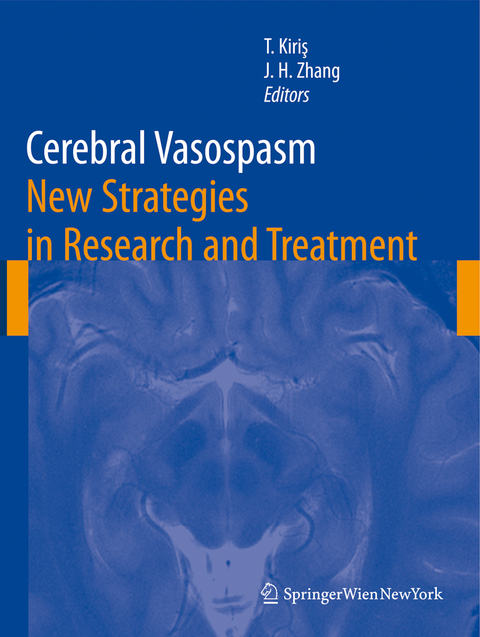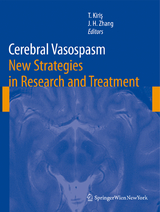Cerebral Vasospasm
Advances in vasospasm research.- Advances in vasospasm research.- Vasospasm pathogenies.- Pre-vasospasm: early brain injury.- Apoptotic markers in vasospasm after an experimental subarachnoid haemorrhage.- Cerebrospinal fluid soluble Fas and Fas ligand levels after aneurysmal subarachnoid haemorrhage.- Time course of oxyhemoglobin induces apoptosis in mice brain cells in vivo.- Inhibition of c-Jun N-terminal kinase pathway attenuates cerebral vasospasm after experimental subarachnoid hemorrhage through the suppression of apoptosis.- Oxidative stress in subarachnoid haemorrhage: significance in acute brain injury and vasospasm.- Bilirubin oxidation products (BOXes): synthesis, stability and chemical characteristics.- Vascular contractility changes due to vasospasm induced by periarterial whole blood and thrombocyte rich plasma.- Vasospasm biochemistry.- Vasospasm biochemistry.- The roles of cross-talk mechanisms in the signal transduction systems in the pathophysiology of the cerebral vasospasm after subarachnoid haemorrhage what we know and what we do not know.- Subarachnoid hemorrhage induces upregulation of vascular receptors and reduction in rCBF via an ERK1/2 mechanism.- Effect of deferoxamine-activated hypoxia inducible factor-1 on the brainstem following subarachnoid haemorrhage.- Urgosedin downregulates mRNA expression of TNF-? in brain tissue of rats subjected to experimental subarachnoid haemorrhage.- Nucleotide-induced cerebral vasospasm in an in vivo mouse model.- Effects of ADPbetaS on purine receptor expression in mouse cerebral vasculature.- Vasospasm electrophysiology.- Electrophysiology of cerebral vasospasm.- Cellular basis of vasospasm: role of small diameter arteries and voltage-dependent Ca2+ channels.- Acute and chronic effects of oxyhemoglobin on voltage-dependent ion channels in cerebral arteries.- The effect of an intracisternal nimodipine slow-release system on cerebral vasospasm after experimental subarachnoid haemorrhage in the rat.- Cerebral vasospasm following subarachnoid haemorrhage is completely prevented by L-type calcium channel antagonist in human.- Vasospasm pharmacology.- Vasospasm pharmacology.- Endothelin-converting enzyme inhibitor versus cerebrovasospasm.- A pharmacokinetic study of clazosentan in patients with aneurysmal subarachnoid haemorrhage.- Pharmacokinetic and pharmacodynamic aspects of the interaction between clazosentan and nimodipine in healthy subjects.- Attenuation of intercellular adhesion molecule-1 and cerebral vasospasm in rabbits subjected to experimental subarachnoid haemorrhage by CGS 26303.- The effect of 17?-estradiol in the prevention of cerebral vasospasm and endothelin-1 production after subarachnoid haemorrhage.- Dysfunction of nitric oxide synthases as a cause and therapeutic target in delayed cerebral vasospasm after SAH.- An adenosine A1 receptor agonist preserves eNOS expression and attenuates cerebrovasospasm after subarachnoid haemorrhage.- Vasospasm molecular biology.- Gene transfer after subarachnoid hemorrhage: a tool and potential therapy.- Direct protein transduction method to cerebral arteries by using 11R: new strategy for the treatment of cerebral vasospasm after subarachnoid haemorrhage.- Endothelial nitric oxide synthase-11R protein therapy for prevention of cerebral vasospasm in rats: a preliminary report.- Microarray analysis of hemolysate-induced differential gene expression in cultured human vascular smooth muscle cells (HVSMC).- Vasospasm remodeling.- Role of vascular remodeling in cerebral vasospasm.- Possible role of tenascin-C in cerebral vasospasm after aneurysmal subarachnoid haemorrhage.- Ecdysterone-sensitive smooth muscle cell proliferation stimulated by conditioned medium of endothelial cells cultured with bloody cerebrospinal fluid.- The effect of oxyhemoglobin on the proliferation and migration of cultured vascular advential fibroblasts.- The effect of oxyhemoglobin on the proliferation and migration of cultured vascular smooth
| Erscheint lt. Verlag | 25.3.2008 |
|---|---|
| Reihe/Serie | Acta Neurochirurgica Supplement |
| Zusatzinfo | XIII, 454 p. |
| Verlagsort | Vienna |
| Sprache | englisch |
| Maße | 210 x 279 mm |
| Themenwelt | Medizinische Fachgebiete ► Chirurgie ► Neurochirurgie |
| Medizin / Pharmazie ► Medizinische Fachgebiete ► Neurologie | |
| Medizinische Fachgebiete ► Radiologie / Bildgebende Verfahren ► Radiologie | |
| Schlagworte | biochemistry • neural intensive care • Neurology • neurosurgery • subarachnoid hemorrhage • traumatic brain injury |
| ISBN-10 | 3-211-75717-1 / 3211757171 |
| ISBN-13 | 978-3-211-75717-8 / 9783211757178 |
| Zustand | Neuware |
| Informationen gemäß Produktsicherheitsverordnung (GPSR) | |
| Haben Sie eine Frage zum Produkt? |
aus dem Bereich




